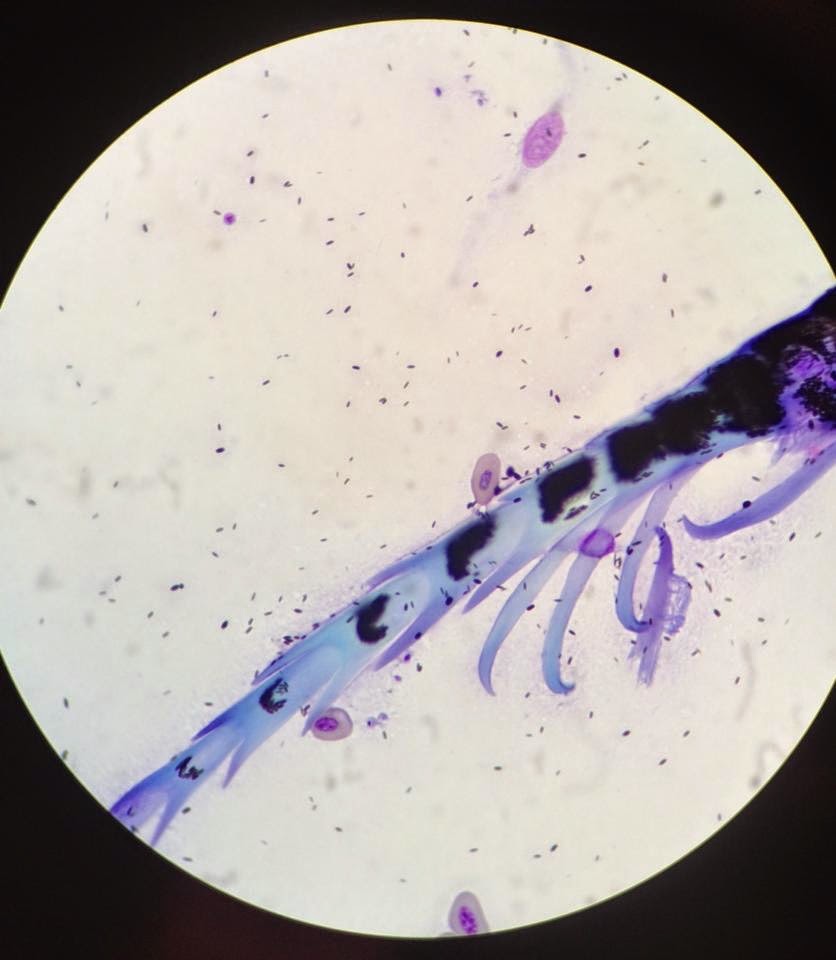Depending on size, species
and age, birds may have between 940 (hummingbird) and 25,216 (swan) feathers.
Each of these feathers is molted and replaced on average every six months.
Feathers on a bird are not evenly distributed. They grow in
distinct tracts or lines called pterylae, inbetween areas of bare skin called
apteria. The apteria help cool the
bird. Apteria vary in size and are
typically covered with contour, or body feathers, that overlap the
apteria. Because of the effects of
water on feathers and ultimately on body temperature, water birds have small
apteria and penguins have almost none.
New feathers emerging on the head of an African grey parrot. (photo: Dawn Trainor Griffard)
As a bird molts a feather,
the new emerging feather pushes up into the base of the older feather,
eventually forcing the older feather out of the follicle (place of feather
growth) altogether. As a new feather grows into place, it is nourished with
blood by a small artery, which allows for its growth.
The growing sheath the new feather,
along with the feather itself, is formed of keratin – just like human fingernails. The growing sheath is semi-sharp and hard enough so it can press through
the epidermis (outer layer of skin).
During a heavier molt, this is the part of the process that makes our
companion birds a little uncomfortable and crabby. It’s probably an annoying
and itchy process!
Actively growing primary flight feather with a blood supply (photo: Dawn Trainor Griffard)
Before the new feather
erupts from the growth sheath, it’s referred to
as a “pin” feather until the keratin sheath falls off or is removed, and you
can see the actual feather. As the feather grows the protective
sheath either sloughs off or is preened off by
the bird. When a feather completes its growth, the blood supply to the feather stops.
Problems can arise when a
feather is accidentally damaged during its growth period. If a blood feather is
damaged during its development, it can bleed profusely, endangering the health
of the bird. Birds with actively bleeding blood feathers must be attended to immediately. However, only intervene if the feather
will not stop bleeding. Usually
the broken blood feather bleeds a little, then stops bleeding on its own. Then the body usually stops blood flow
to the feather, the bird preens the broken feather out, and a new feather
starts to grow. It’s most
important to figure out how the bird broke the feather and make sure it doesn’t
happen again.
Microscopic view of the “birth” of a feather (photo: Dawn Trainor Griffard)
If the bleeding will not
stop, the blood feather is either carefully trimmed or completely pulled out –
the latter of which is probably a painful procedure as the feather is often
attached to a bone, so removal must be done expertly and quickly.
If the damage is slight yet
the bleeding won’t stop, you can stop it with
cornstarch and/or direct pressure. However, care must be taken that the feather
does not receive further damage. In
almost all instances the bird would have to be restrained for this procedure,
so letting the bird’s body naturally take care of the broken blood feather is
best.
Through its daily preening,
the growth sheath is removed by the bird itself
or a conspecific – usually the mate. In captivity, the bird’s keeper can often gently
remove those growth sheaths the bird cannot reach (like on the back of the head),
as long as the bird tolerates being touched.
At the World Bird Sanctuary our birds are fed nutritious diets and are monitored very closely to
ensure that the molting process goes smoothly. If we see that one of our birds is having a problem with a bloodfeather
or that a growth sheath is not being shed, we can step in and intervene to
ensure the health and comfort of our birds.
Submitted by Dawn Trainor Griffard, World Bird Sanctuary Naturalist







No comments:
Post a Comment